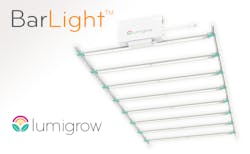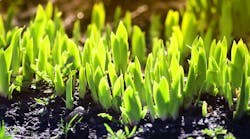Seoul Semiconductor has released the results of a laboratory research project that compared lettuce yields under different solid-state lighting (SSL) spectra and that showed an advantage for its own SunLike LED technology. LumiGrow has announced a new luminaire family called BarLight intended to support cannabis growing operations in a vertical farm configuration. Moreover, LumiGrow is offering new sensors that can offer early detection of plant pathogens in commercial growing operations.
Lettuce growth tests
Seoul’s lettuce research clearly does not come with the credentials of a full academic research project, but it was interesting in that the project sought to both capture basic yield improvement and increased beneficial nutrients. Specifically, the study compared the fresh weight of plants grown under different spectral power distribution (SPD). And the researchers compared flavonol or antioxidant content of the lettuce samples. The research team was headed by Dr. JinWon Kim, principal researcher at Seoul Viosys.
The test compared the use of horticultural lighting based on SunLike LEDs with lights based on phosphor-converted white LEDs that are typical of mainstream LEDs sold across the SSL sector. SunLike LEDs are intended to deliver a more uniform spectrum with no energy peaks or troughs, more closely mimicking the SPD of the sun than do typical white LEDs.
The tests ran for a two-week period. The lettuce was under light for 16 hours each day, with both the SunLike and typical-white fixtures delivering PPFD (photosynthetic photon flux density) of 200 μmol/m2/sec. For more background on horticultural metrics such as PPFD, see one of our prior feature articles on horticultural lighting.
After two weeks, the lettuce revealed an easy-to-understand advance in fresh weight with the SunLike samples averaging 43g — 13.5% higher than the lettuce grown under standard white SPD. The antioxidant advantage is far more difficult to explain. The researchers set to measure the flavonol index, taking leaf measurements using a test instrument manufactured by Dynamax. The company’s literature says that the device can take nondestructive flavanol, anthocyanin, and chlorophyll measurements from leaves.
Apparently, the flavonol index is deduced from how well the leaves absorb ultraviolet (UV) energy. A higher index number indicates higher flavonol content, although there are no units associated with the index score. The lettuce grown under SunLike was found to have an index of 0.55 — 41% higher than the samples grown under standard LEDs.
LumiGrow vertical cannabis
The new LumiGrow BarLight fixtures, meanwhile, consist of linear LED bars that connect to LumiGrow’s EasyRail platform for mounting and powering horticultural lighting, allowing a grower to easily customize the footprint, or more appropriately, beam distribution or pattern over a rack of plants.
Many cannabis growers have used a floorplan where plants are clustered under a high-pressure sodium (HPS) fixture. And SSL manufacturers have attempted to build LED-based fixtures that approximate the beam of such an HPS fixture in shape and energy. But where LEDs may ultimately shine the brightest for cannabis growing is in operations where the floorplan is reconfigured and where the LED lighting is brought near the plant canopy to enable multiple vertical layers of plants. We published one case study on such a growing operation last year. The layers aren’t nearly so dense as in vertical farms that grow leafy greens, yet the layers still enable more output per square foot of floor space relative to conventional clusters of plants.
The BarLight fixtures are designed to mount over 4×8-ft racks of plants. Growers can customize the density of the light bars. Moreover, LumiGrow is offering the products with white and pink (red plus blue) SPDs. As with all LumiGrow products, the BarLight fixtures can be combined with the company’s wireless connected SSL platform called smartPAR.
Pathogen sensors
Indeed, the other product that LumiGrow announced recently relies on smartPAR and is based on a technology partnership with Scanit Technologies. The SporeCam sensors can be installed on the luminaire infrastructure to monitor plants. The sensors can capture and identify pathogens on plants such as powdery mildew and Botrytis. Growers can act on sensor data to proactively eliminate pathogens and preserve yield in their operations.
“Our partnership with Scanit Technologies marks a major shift in how crop disease will now be managed,” said LumiGrow CEO Jay Albere. “It all starts with empowering growers to take preventative action towards disease management rather than being forced to issue treatment actions when it’s often too late. We’re now calling for growers interested in joining our partnership to develop custom strategies for their cultivation environments.”
We will surely learn more on topics such as plant pathogens, optimization of growing operations, and ideal SPD for cultivars at our upcoming Horticultural Lighting Conference. The event is scheduled for Oct. 31 in Denver, CO. Also, our Strategies Unlimited organization has a new market research report available covering the North American cannabis lighting market.





